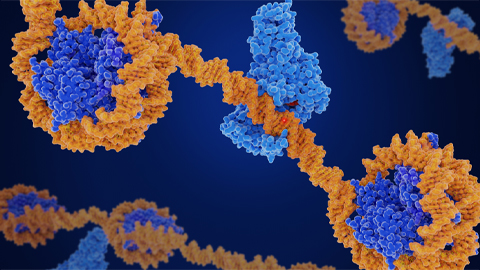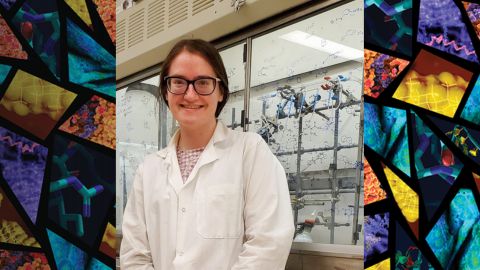Bubbly biochemistry: Understanding the components of sparkling wine
Whether or not your holiday celebrations involve imbibing, the cultural link between champagne flutes and festivities is strong. The fizz and pop of sparkling wine give breaking out the bubbly a special pizzazz.

In the first glycoproteomics study of its kind, a research team reports in the journal Molecular & Cellular Proteomics that glycoproteins are an important part of keeping those bubbles in solution. Cassandra Pegg and colleagues at the University of Queensland put a variety of sparkling wines under the microscope — or, more accurately, into the mass spectrometer — in hopes that the work would lead to better wine-making methods.
“Sparkling wine is really difficult to pipette,” Pegg, a postdoctoral researcher in Ben Schulz’s lab, said. “We have had some sets of samples that were gushing” — that’s a wine-biz term for when bubbles won’t stay in solution — “and the tubes would pop open in the lab.”
Gushing, when champagne or cava comes foaming out of an opened bottle, entertained Pegg and her colleagues. But it’s less than desirable commercially: Winemakers want the dissolved gas to come out of solution slowly, making a beverage that continues to bubble until it’s finished.
Sparkling wine’s carbonation results from two rounds of fermentation. After producing a base wine, winemakers mix in a solution of yeast and sugar and seal it all into a bottle to trap the carbon dioxide the yeast produce. The yeast strain, grape blend and tweaks to the production process can affect the quality of the final product — but the process is often a matter of trial and error.
To understand more about molecular attributes leading to positive prosecco properties, the researchers degassed samples of sparkling wine that had been aged for different periods or fermented with different strains of yeast. They used proteomic and glycoproteomic techniques to characterize the brews. Wine doesn’t have much protein, and most of the proteins they found were secreted by yeast or found in their cell walls. A surprisingly high proportion were glycosylated, or modified with complex sugar molecules.

As wines age, their proteins and glycopeptide constituents change. According to Ben Schulz, the professor who led the work, changes late in the aging process, when “no biology should be happening,” probably depend on the biophysics of protein solubility. Glycosylation can make a peptide more water-soluble and less likely to clump into sediment.
Similar principles may guide a wine’s propensity to gush. Researchers previously had found that a yeast cell wall protein called seripauperin 5 can stabilize foam; this and related proteins were among the most abundant that Schulz’s team identified.
“It’s not completely understood,” Schulz said of the protein’s foam-stabilizing effect. “But from a biophysical standpoint, it makes sense: Glycans tend to be hydrophilic, and peptides hydrophobic.” By clustering at the interfaces between liquid and gas, small glycopeptides could affect a wine’s surface tension and change the rate at which dissolved gas coalesces into bubbles and escapes.
By understanding the production methods that affect seripauperin 5 and other glycoproteins, Schulz said, he hopes to work in the future with winemakers looking to optimize their products.
Enjoy reading ASBMB Today?
Become a member to receive the print edition four times a year and the digital edition monthly.
Learn moreGet the latest from ASBMB Today
Enter your email address, and we’ll send you a weekly email with recent articles, interviews and more.
Latest in Science
Science highlights or most popular articles

CRISPR epigenome editor offers potential gene therapies
Scientists from the University of California, Berkeley, created a system to modify the methylation patterns in neurons. They presented their findings at ASBMB 2025.

Finding a symphony among complex molecules
MOSAIC scholar Stanna Dorn uses total synthesis to recreate rare bacterial natural products with potential therapeutic applications.

E-cigarettes drive irreversible lung damage via free radicals
E-cigarettes are often thought to be safer because they lack many of the carcinogens found in tobacco cigarettes. However, scientists recently found that exposure to e-cigarette vapor can cause severe, irreversible lung damage.

Using DNA barcodes to capture local biodiversity
Undergraduate at the University of California, Santa Barbara, leads citizen science initiative to engage the public in DNA barcoding to catalog local biodiversity, fostering community involvement in science.

Targeting Toxoplasma parasites and their protein accomplices
Researchers identify that a Toxoplasma gondii enzyme drives parasite's survival. Read more about this recent study from the Journal of Lipid Research.

Scavenger protein receptor aids the transport of lipoproteins
Scientists elucidated how two major splice variants of scavenger receptors affect cellular localization in endothelial cells. Read more about this recent study from the Journal of Lipid Research.

